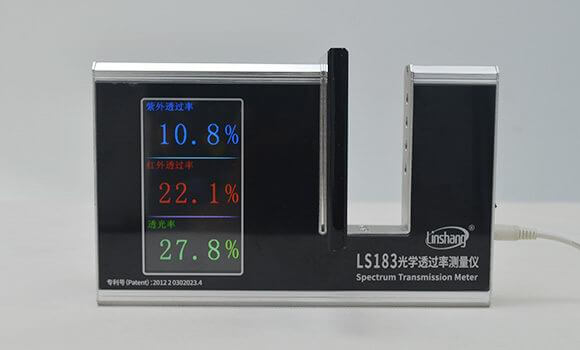Laminated Glass and Light Transmittance Test
The laminated glass are processed by autoclave, intermittent or continuous vacuum lamination, on-site casting and rapid fusion RF lamination technology. The laminated glass has changed the characteristics of traditional glass to be brittle and hard. The laminated glass is widely used in the isolation and interruption of windshields, transparent windows, business halls, etc. on vehicles. Compared with traditional glass, laminated glass have many advantages. Linshang light transmittance tester can measure the VLT ( visible light transmittance), UV transmission rate and IR transmission rate of the laminated glass.

I. Features and functions of laminated glass
1. Sound insulation function
The sound insulation function is mainly achieved by the PVB interlayer film material between the two layers of glass. The "plastic" of PVB is very similar to the plastic packaging film we use every day. The raw material is white and translucent. It can be completely transparent after high-temperature and high-pressure treatment. PVB film can impede the sound waves of the outside world and reduce the impact of external noise on the cabin. Compared with traditional tempered glass, this film in laminated glass can reduce the external noise by 3-5 decibels.
2. UV protection function
Laminated glass can block more than 95% of ultraviolet rays. So if we use the laminated glass on the car, in theory, there is no need to attach another window film on the automobile windshield. Although it can cut off ultraviolet light, its visible light transmittance is still similar to traditional glass, which makes privacy insecure. If you mind that a dark film can be attached, the LS183 transmittance meter can measure both ultraviolet , infrared transmittance and visible light transmittance. The working principle of LS183 light transmittance tester is to use ultraviolet light source, infrared light source and visible light source to illuminate the transparent materials. The ratio of light intensity to incident light intensity is the transmittance, expressed as a percentage. The LS183 glass transmittance tester can pass the inspection of China Institute of Metrology.

3. Lightweight
The tempered glass used on a compact SUV, including front and rear windshields, windows and panoramic sunroof. If the windows and sunroof glass are all replaced by traditional 5mm thick tempered glass to 4mm thick laminated glass, the weight can be reduced by about 12 kg. The weight reduction effect is still quite obvious.
4. Security
When a vehicle collides, the window glass may shatter and splash and hurt people. The laminated glass has toughness in the middle of the film. The two layers of glass have been closely attached to itself during manufacturing, so the glass slag rarely splashes during impact. This feature is also conducive to anti-theft. If a thief tries to break the window, his effort and time will be several times that of breaking the traditional tempered glass.
II. Measure VLT, UV/IR transmission of laminated glass
As mentioned above, the LS183 glass transmittance tester can be used to measure the transmittance of laminated glass. The LS183 light transmittance tester is mainly suitable for measuring the optical performance of materials such as thermal insulation coatings, single-layer glass, laminated glass (insulating glass), stick-film glass, PMMA, PC materials, etc. It can simultaneously measure the transmittance of ultraviolet and infrared rays, the width of the test slot is 47mm.
This transmittance tester use parallel light path and the data is also accurate when measuring large thickness materials. The working principle of the LS183 glass transmittance tester is to use an ultraviolet light source, an infrared light source and a visible light source to illuminate the transparent material. The sensor detects the incident light intensity of the three light sources and the light intensity after passing through the transparent material. The ratio of light intensity to incident light intensity is the transmittance, expressed as a percentage.
Through the above introduction, we believe everyone knows the advantages of laminated glass in function and safety. Even if compared with stick-film glass, it has certain advantages in safety.
- Linshang Insulated Glass Unit Measuring Tools
- Spectacle lens anti-blue light detection---blue-violet light transmittance meter
- Measurement of Optical Density
- Difference of LS116 Transmission & LS117 OD Meter
- Difference between LS116 and LS117 Light Transmittance Meter
- What’s the Difference Between Point Light and Parallel Light Transmittance Meter